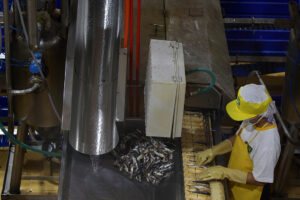2024 factory output growth eases
The country’s industrial production growth eased annually in 2024 amid geopolitical tensions that dragged demand, the Philippine Statistics Authority (PSA) reported on Friday. Preliminary data from the PSA’s latest Monthly Integrated Survey of Selected Industries showed that factory production, as measured by the volume of production index (VoPI), inched up by 0.9% on average last […]

The country’s industrial production growth eased annually in 2024 amid geopolitical tensions that dragged demand, the Philippine Statistics Authority (PSA) reported on Friday.
Preliminary data from the PSA’s latest Monthly Integrated Survey of Selected Industries showed that factory production, as measured by the volume of production index (VoPI), inched up by 0.9% on average last year, slowing down from the 4.9% growth in 2023.
This was the lowest year-on-year growth in four years or since the sharp 40.5% contraction during the coronavirus pandemic in 2020.
In December, VoPI inched up by 0.2% year on year, ending three straight months of decline.
It reversed the revised 3.9% drop in November. However, it was slower than the 3% recorded in December 2023.
On a seasonally adjusted month-on-month basis, industrial production rose by 4% in December, a turnaround from the 1.9% fall in November.
In comparison, the S&P Global’s Philippines Manufacturing Purchasing Managers’ Index (PMI) climbed to 54.3 in December from 53.8 in November. The country’s fastest since the 54.8 reading in November 2017.
A PMI reading below 50 marks a contraction in the manufacturing sector, while a print above 50 marks an expansion.
Sergio R. Ortiz-Luis, Jr., honorary chairman at the Philippine Chamber of Commerce and Industry, said in a phone interview that geopolitical tensions might have caused a decrease in production orders.
“There’s a lot of orders that were lost [last] year and that’s why I think geopolitics has affected this because we have lost a lot of trade. We lost a lot of visitors, a lot of investment from China,” Mr. Ortiz-Luis Jr., who also sits as the president of the Philippine Exporters Confederation, Inc., said.
He also added China moved to doing business with other Southeast Asian nations.
“While we’re increasing slowly, we’re being left behind by our neighbors who are getting the bulk of the orders and investment from China,” he said.
“I hope geopolitics can improve, I think they have to, and the tensions lessen. There is a decrease in our electronics [exports], which should have been strong, but is getting weak,” he added.
John Paolo R. Rivera, senior research fellow at the Philippine Institute for Development Studies, said in a Viber message that the easing in manufacturing output last year suggests “softer” industrial and export activity.
“This aligns with broader economic headwinds, including tighter financial conditions and weaker global demand. It could indicate hesitation among firms to expand capacity due to uncertainty in demand, high interest rates, or elevated operating costs,” Mr. Rivera said.
He added that export manufacturing struggled, which may reflect “weak” global demand from China and the US.
Meanwhile, Mr. Rivera said the slight uptick in December was due to several factors such as improvements in logistics and raw material availability, policy support for the manufacturing sector, potential decline in global oil prices and easing inflationary pressures.
However, he attributes the slower growth to weak external demand, higher borrowing costs, and weak private sector investments.
The PSA attributed the slight increase in December’s factory output growth rate to the manufacture of computer, electronic and optical products which was up 4.3% from a 5.8% decline in November, coke and refined petroleum products (4.4% from -11.6%), and transport equipment (6.1% from -0.2%).
Average capacity utilization rate in December reached 75.5% in December, slightly down from 75.7% in November.
Nineteen out of 22 industry divisions posted average capacity utilization rates of at least 70%.
“The manufacturing sector’s prospects for 2025 will hinge on monetary policy easing, recovery in global trade from major economies like US, China, and ASEAN… and increased infrastructure spending, industry incentives and investment-friendly policies,” Mr. Rivera said.
“If inflation stabilizes and energy costs remain manageable, production costs may ease, supporting growth,” he added.
The Bangko Sentral ng Pilipinas (BSP) kicked off its easing cycle in August last year, slashing key interest rates by a total of 75 basis points by the end of 2024.
The BSP expects inflation to settle at 3.3% this year, within the 2-4% target. — Kenneth H. Hernandez


















